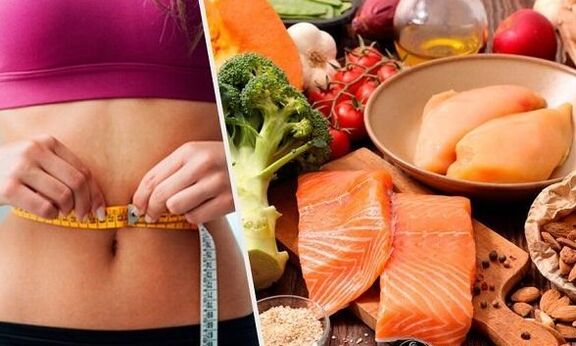The Keto Diet (Keto) is a very low-carb diet that helps burn fat. It has many advantages in weight loss and improved health, but also has some side effects.

- Advantages of a keto diet
- Keto diets are prohibited
- How to find out what you are doing in Ketoss?
- Side effects of diet and how to avoid them
The ketogenic diet is similar to other strict low-carb diets, such as the Atkins or LCHF diet. These diets usually end with accidental ketogenicity. The main difference between a strict LCHF and a keto diet is that proteins are restricted in the latter.
Using ketosis, the body produces small fuel molecules called "ketones". This is the body's alternative fuel.
If you eat very few carbohydrates (quickly divided into blood sugar) and a proper amount of protein (which can also convert excess protein into blood sugar), ketones will be produced.
How to lose weight baby food?
Ketones are formed in the fatty liver. They are then used as fuel for the entire body, including the brain. The brain is an organ that consumes a lot of energy every day and cannot directly work on fat. He can only use glucose or ketones.
In a ketogenic diet, your entire body converts from the fuel supply of carbohydrates, working almost entirely on fat. Insulin levels become very low and fat burns increase dramatically. The body easily gets its own fat reserves to burn them.
Advantages of a keto diet
The advantages of a ketogenic diet are similar to any strict low-carb diet. However, because proteins are limited, the effect may be higher. This diet increases ketone levels and lowers insulin levels.

- The fat burned on the keto diet increases significantly because insulin decreases. This creates the ideal conditions to lose weight without hunger.
- About 20 scientific studies have shown that a low-carb and keto diet leads to more effective weight loss than other diets.
- Ketosis causes sustainable fuel intake (ketone) to enter the brain. On a ketogenic diet, you will avoid a lot of fluctuations in your blood sugar. This often leads to increased attention and increased concentration.
- Many people use a keto diet specifically to improve their psychological performance. After a few days (up to a week), ketone adapts, during which a person may experience some difficulties due to concentration, headaches, irritability - the body and brain switch and can easily use ketone.
- In a state of ketosis, many people experience more energy.
- A ketogenic diet can also significantly increase your body's endurance, allowing you to continuously gain energy from your fat reserves.
- It is enough to supply the body with carbohydrates (glycogen) for only a few hours of intensive training. When your fat reserves will provide enough energy for long and intensive courses.
Keto diets are prohibited
Most importantly, to achieve ketosis, you need to avoid carbohydrates, ideally reducing your consumption to below 20 grams. The less carbohydrates, the more effective.
How to find out what you are doing in Ketoss?
Ketopathy can be measured by testing urine, blood, or breathing. But there are clear signs. Symptoms of ketosis: dry mouth, thirst, frequent urine.
Dry mouth, thirsty. If you drink enough and have enough electrolytes, you will feel dry mouth. Try drinking one or two cups of soup a day, plus the water you need.
Increased urination is another symptom of ketosis.

The ketone is dried until the ketone body, and the smell of acetone appears from the mouth, which can also be "fruit", or something similar to a varnish liquid. Sometimes this smell is felt from sweat, and it all goes by a while and then passes after the ketone is adapted.
Other more specific, but more positive signs include:
Reduce hunger – Many people are significantly less hungry. This may be caused by an increase in the body's ability to feed through its fat reserves. Many people feel good, eat only once or twice a day, and you can fast regularly. This saves time and money and speeds up weight loss.
Increase in energy - After a few days, fatigue will pass and you will feel an increase in energy and performance.
How to achieve sustainable ketosis
- Limit up to 20 grams of carbohydrates per day.
- Squirrels are limited to medium levels. Levels per kilogram of body weight must be maintained per day or below 1 gram of protein. If you weigh 70 kg, you will be about 70 grams of protein per day.
- Have enough fat to feel full.
- Avoid snacks when you are not hungry. Unnecessary snacks reduce weight loss and reduce ketosis.
If necessary, you need to add periodic hunger, for example, hunger and food consumption for 8 hours 16: 8-16 hours. This is very effective for adding ketones.
Side effects of diet and how to avoid them

During the initial stages of transitioning to the keto mode, side effects may occur - this is called keto -gripp. Symptoms such as fatigue, nausea, headache, cramps, etc. What measures are needed to prevent or alleviate these symptoms:
- Drink salt and lemonade - you also need a cup of soup a day.
- Gradually reduce carbohydrate consumption - sharp decreases can lead to stronger symptoms
In the initial stages of a ketogenic diet, you lose water and therefore electrolytes. This happens because carbohydrates delay water and salt in the body, so when you stop eating carbohydrates, your body loses this water.
When carbohydrates are suddenly removed from your diet, it takes time for the brain to learn to use ketone bodies instead of sugar. This means that if you reduce carbohydrates sharply, you can get symptoms such as fatigue, nausea, and headaches. Reduce carbohydrate consumption for a week or more, the body will get used to burning fat and ketones instead of glucose, and the transition will be easier and asymptomatic.






























